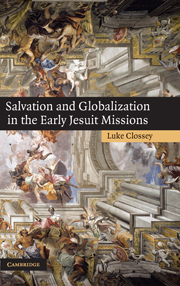Book contents
- Frontmatter
- Contents
- List of Tables and Charts
- Acknowledgments
- 1 Introduction
- 2 Organizing the Society of Jesus
- 3 Decentralizing the Society of Jesus
- 4 Imagining Global Mission
- 5 Space, Time, and Truth in the Jesuit Psychology
- 6 The Missionary Motivation
- 7 The Jesuit Missionary Network
- 8 The Jesuit Financial Network
- 9 The Jesuit Information Network
- 10 The Jesuit Sacred Economy
- 11 An Edifying End: Global Salvific Catholicism
- Appendix A Abbreviations for Document Sources
- Appendix B Chronological Tables (1540–1722)
- Appendix C Principal Prosographical Information
- Appendix D Monetary Systems
- Works Cited
- Index
11 - An Edifying End: Global Salvific Catholicism
Published online by Cambridge University Press: 28 July 2009
- Frontmatter
- Contents
- List of Tables and Charts
- Acknowledgments
- 1 Introduction
- 2 Organizing the Society of Jesus
- 3 Decentralizing the Society of Jesus
- 4 Imagining Global Mission
- 5 Space, Time, and Truth in the Jesuit Psychology
- 6 The Missionary Motivation
- 7 The Jesuit Missionary Network
- 8 The Jesuit Financial Network
- 9 The Jesuit Information Network
- 10 The Jesuit Sacred Economy
- 11 An Edifying End: Global Salvific Catholicism
- Appendix A Abbreviations for Document Sources
- Appendix B Chronological Tables (1540–1722)
- Appendix C Principal Prosographical Information
- Appendix D Monetary Systems
- Works Cited
- Index
Summary
“Both had an edifying end, dying on the high seas before arriving at Goa.”
– Eusebius Kino, on Amrhyn and AigenlerKino's obituary for his colleagues characterized their deaths as “edifying” because they departed this life only after leaving Europe to work as missionaries in Asia. A modern observer unsympathetic to their proselytizing mission might recognize these deaths as appalling ends to misguided lives, while even a modern Catholic might regard them as tragic failures that aborted worthy missionary work before it began. Why did Kino cast them in such a positive light? This study's findings have suggested an answer. Contracting the plague while ministering to its victims, Beatus Amrhyn and Adam Aigenler died as missionaries, and indeed as missionaries who would be working far from home. As we have seen, in the early-modern Jesuit understanding both these factors could have positive and crucial soteriological consequences. Ultimately their missions were at least partially successful in that they worked toward the salvation of their own souls. What wider consequences does the attitude and behaviour of these Jesuit missionaries have for the Catholicism of that time? Although the Protestant Reformation achieved early a remarkable stability as a historical concept, historians have never achieved a similar consensus about what has been called the Catholic Reformation, Catholic Renewal, Catholic Renaissance, and Catholic Refashioning. Within the last fifty years historians have suggested three major approaches: the pair of Counter Reformation and Catholic Reform, Confessionalization, and Early Modern Catholicism.
- Type
- Chapter
- Information
- Salvation and Globalization in the Early Jesuit Missions , pp. 238 - 258Publisher: Cambridge University PressPrint publication year: 2008



